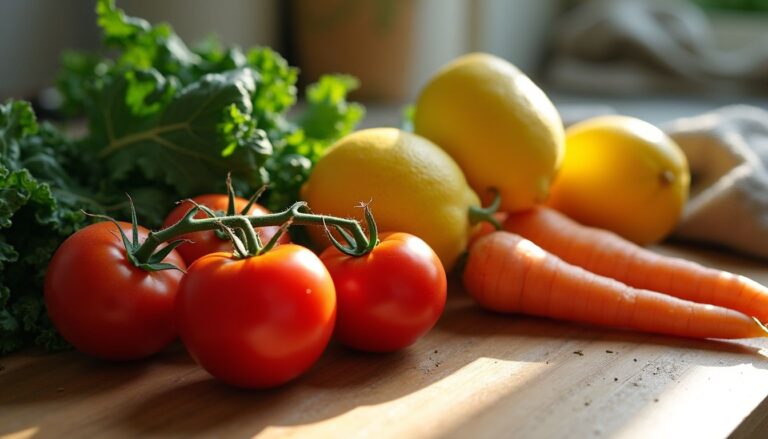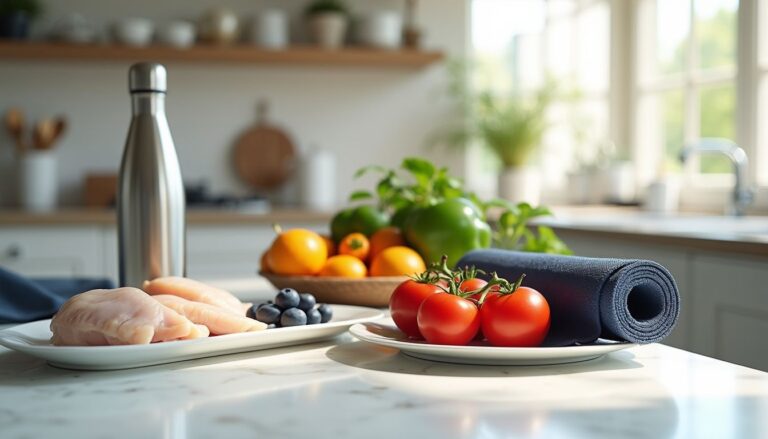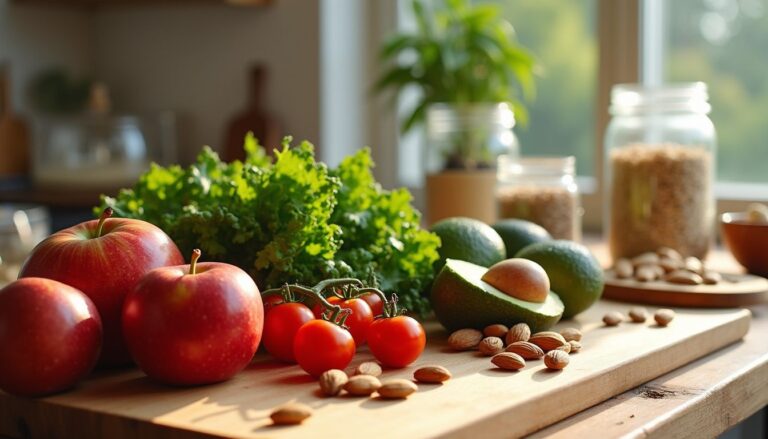Effective Fat Loss Diet Plan For Men: Your Ultimate Meal Plan For Weight Loss
Our Nutrition Assistant AI Suite will transform your body. You will lose fat, get toned, and build muscle. Gain confidence and optimal health.
Understanding how fat loss works helps you choose better foods and routines. Think of calories like a budget. Spend less than you earn, and progress follows.
Why Is a Calorie Deficit Important for Fat Loss?
A calorie deficit means eating fewer calories than you burn each day. Most men do well aiming for 500 to 750 fewer calories per day, which often equals about one pound lost per week.
Tracking intake keeps hidden calories in check. Sugary drinks, candy, and beer add energy without much nutrition. Simple tactics such as using smaller plates and pausing between bites make portion control easier, even without strict counting.
A quick swap, like replacing an afternoon soda with water, can lead to steady progress within weeks. Small changes add up and make your plan easier to maintain.
How Does Balanced Nutrition Affect Weight Loss?
A balanced plate supports fat loss and your health. The Mayo Clinic Diet highlights vegetables, fruits, whole grains, beans, nuts, fish, and healthy fats.
Eating across all food groups supplies vitamins and minerals you need. Filling your plate with produce lowers calorie intake and supports heart and metabolic health. Fiber from whole grains and beans improves digestion and helps control hunger, which makes a calorie deficit easier to sustain.
Choose mostly whole grains instead of refined grains to keep energy steady during exercise and daily tasks. Balanced meals help you lose fat and keep it off without feeling deprived.
How Can Exercise Complement Your Diet?
Nutrition sets the base, and exercise accelerates results. The U.S. Department of Health and Human Services suggests 150 minutes of moderate exercise or 75 minutes of vigorous exercise weekly.
Walk, jog, cycle, or swim for cardio. Add strength training at least twice a week to protect lean muscle while you lose fat. Short choices count too. Taking stairs, standing more, and short walks between tasks raise daily calorie burn.
Regular movement supports discipline in your meal plan for men and improves long-term habits.
Nutritional Guidelines for an Effective Fat Loss Diet Plan
A healthy diet plan for fat loss centers on nutrient-dense foods, portion control, and steady routines. Use these guidelines to support your goals and overall health.
How Does Portion Control and Meal Timing Help Fat Loss?
Portion control keeps your calories in range. Many people misjudge serving sizes, even for healthy foods, and end up overeating.
Smaller plates and clear serving targets help. Plan regular meal times to manage appetite and reduce impulse snacking. When meals are spaced through the day, energy stays steady and hitting your calorie target gets easier.
Why Choose Whole Foods Over Processed Foods?
Whole foods like fruits, vegetables, legumes, plain dairy, and intact grains deliver more fiber, vitamins, and minerals than highly processed items. This supports weight loss and health.
Example: a bowl of oatmeal with nuts offers steady energy and better fullness than instant cereal with added sugars. Ultra-processed foods often pack extra calories, sodium, and additives that work against your goals.
Research from 2019 found higher intake of ultra-processed foods leads to higher BMI and more risk factors for obesity and type 2 diabetes. Swapping packaged cereal for Greek yogurt and fruit often reduces calories and curbs cravings later in the day.
Check labels. Long ingredient lists with many additives or trans fat usually signal heavy processing. Whole foods support a healthier metabolism and a lower risk of hypertension and heart disease.
How Can You Reduce Added Sugars and Saturated Fats?
Cut added sugars by reading labels and skipping soda, candy, sweetened juices, and sugary cereals. The American Heart Association suggests men cap added sugars at about 9 teaspoons, 150 calories, per day.
Choose lean proteins and plant-based options more often than red meat, butter, and full-fat dairy. Limit fried foods and pastries that raise saturated fat and trans fat. Cooking at home with simple ingredients makes these targets easier to meet.
Next, explore high-protein choices that help you burn fat while staying energized.
Key Components of a Fat Loss Diet Plan for Men
Winning plans combine high-fiber foods, enough protein, smart calories, and steady carbs. The right mix helps you lose fat while keeping muscle.
What Are the Best High-Protein Foods for Fat Loss?
Lean meats like skinless chicken and lean beef work well. Fatty fish such as salmon and tuna bring protein plus omega-3 fats. Plant proteins like tofu, beans, lentils, chickpeas, quinoa, and oats also fit nicely.
Nuts and seeds add healthy fats with protein. Many men do best eating 20 to 30 percent of calories from protein during weight loss. A protein-rich breakfast, like eggs or Greek yogurt, often cuts snacking later.
Protein protects muscle while you lower calories or increase activity. It fits both vegetarian and Mediterranean-style eating, so you have many options.
Which Healthy Fats Provide Energy for Weight Loss?
Unsaturated fats supply steady energy and support heart health. Use small amounts of olive oil or similar oils for cooking and dressings. Avocado gives creamy texture and helps meals feel satisfying.
Fatty fish offers omega-3 fats that support blood pressure and heart health. Nuts and seeds bring both protein and healthy fats, useful for busy days and workouts.
Unsaturated fats help manage body fat when used in place of saturated or trans fats. Choose plant-forward sources rather than low-fat products that cut calories but also reduce key nutrients.
How Do Complex Carbohydrates Support Sustained Energy?
Complex carbohydrates digest slowly, which helps keep blood sugar steady. Examples include whole-wheat bread, brown rice, oats, quinoa, and buckwheat.
These foods provide fiber, vitamins, and minerals along with carbs. Aim for at least half of your grains from whole sources. Many people feel fuller longer by swapping white rice for brown rice or quinoa, which can reduce afternoon snacking.
Why Include Fiber-Rich Foods for Better Digestion?
Fiber supports regular digestion and a healthy gut. Beans, lentils, vegetables, fruits, and whole grains deliver fiber plus antioxidants.
Increase fiber gradually. You may notice some gas or bloating at first, which usually improves as your body adapts. Fiber boosts fullness after meals, which helps calorie control and weight management.
Adding more fiber-rich foods is a simple way to support fat loss and daily comfort.
Creating a Sustainable Meal Plan
You need a plan you can follow on busy days. Structure removes guesswork and makes healthy eating the easy choice.
How Can Meal Prepping Improve Your Fat Loss Success?
Meal prepping saves time, cuts stress, and keeps portions on target. It sets you up to hit your calorie goals without last-minute choices.
- Prepping locks in portion control and helps maintain a calorie deficit.
- Structured calorie plans, like 1200, 1600, or 2000 calories, make targets simple to follow.
- Cook balanced meals with lean proteins, complex carbs such as brown rice, plenty of vegetables, and healthy fats like olive oil.
- Pre-made meals reduce reliance on high-calorie convenience foods.
- Planning ahead lowers cravings and prevents rushed, poor choices.
- Batch cooking saves time and makes the healthy choice the fast choice.
- People who plan meals are about 33 percent more likely to stick with weight loss programs long-term.
- Tracking becomes easier because you know each ingredient and serving.
- Grilled chicken or bean-based lunches prepped on Sunday can keep you full and ready for workouts after work.
- Prepping lets you pick whole ingredients, which helps cut added sugars.
With a little routine, meal prep turns your diet plan into a weekly habit that lasts.
What Are Smart Grocery Shopping Tips for Fat Loss?
A smart list and a clear route in the store help you hit your goals. Shop with purpose and keep your cart aligned with your plan.
- Write a detailed list focused on lean proteins, produce, and whole grains.
- Spend most time in the perimeter for produce, dairy, and lean meats. Limit center aisles packed with ultra-processed items.
- Pick whole foods like apples, spinach, eggs, Greek yogurt, and beans. Diets rich in whole foods support fat loss better than heavily processed diets.
- Read labels to spot added sugars, trans fat, and high saturated fat. Short, simple ingredient lists are best.
- Choose healthy fats such as olive oil, nuts, seeds, and fish like salmon or tuna to support energy and heart health.
- Grab mostly whole grains, for example brown rice, oats, or whole-wheat bread, to increase fiber and fullness.
- Plan a seven-day menu, then buy only what you will cook to avoid impulse snacks.
- Hydrate. Add water-rich produce like cucumbers and lettuce. Drinking enough water supports fat loss.
- Sleep well before big shops. Poor sleep can push you toward high-calorie snacks.
- Set a budget so you get variety without extra items that do not serve your goals.
How Should You Adjust Calorie Intake Based on Activity?
Match your calories to your activity level while keeping a deficit. If you sit most of the day, 1,500 to 1,800 calories may work for steady loss.
Very active days might need 2,000 to 2,400 calories while still losing, since burn is higher. Track your steps and workouts to dial in your needs. If you are unsure, a registered dietitian or your clinician can help you personalize targets.
Use this approach to fuel your day and your training while keeping weight moving in the right direction.
Sample 7-Day Fat Loss Meal Plan
Use this sample meal plan for men as a template. Adjust portions to fit your calorie target and taste.
What Does a High-Protein Breakfast Look Like on Day 1?
Have 2 slices of wholegrain toast for two grain serves. Spread 2 teaspoons of polyunsaturated margarine for healthy fats.
Add 1 cup baked beans for plant-based protein and fiber, plus one medium tomato for vitamin C and another vegetable serve. Drink 1 cup, 250 ml, reduced-fat milk or add it to coffee for about 8 grams of protein and calcium. High-protein breakfasts improve fullness and help protect muscle during weight loss, according to the Academy of Nutrition and Dietetics, 2023.
What Are Quick and Healthy Meals for Day 2?
Breakfast: whole grain toast with eggs, red pepper flakes, cilantro, and a squeeze of lime. It takes under 10 minutes and keeps you satisfied.
Lunch: a quick red lentil and spinach soup with curry powder. Red lentils bring plant protein and fiber.
Dinner: juicy chicken breast with colorful vegetables and a light savory sauce. These meals combine lean protein and legumes for filling portions with fewer calories.
How to Prepare a Balanced Day 3 Meal Plan?
Breakfast: feta with avocado and green onions. You get protein, healthy fats, and fiber for longer fullness.
Lunch: black beans seasoned with chili powder and salsa. One cup offers around 15 grams of protein and 15 grams of fiber. Dinner: extra-firm tofu in a hearty chili to boost plant protein. The mix keeps macros balanced for solid satiety.
What Meals Make Up Day 4’s Fat Loss Plan?
Dinner: 100 grams cooked fish fillet with a drizzle of olive oil for lean protein and healthy fats.
Round out the plate with 1 cup boiled rice, 1 medium potato, and 1 cup each of carrots and broccoli. This balance of protein, grains, and vegetables supports fullness, fiber intake, and steady energy.
What Are Tasty and Nutritious Options for Day 5?
Lunch: 2 slices wholegrain bread with 65 grams roast beef and 20 grams reduced-fat cheese. Add 2 teaspoons margarine and 1 cup mixed salad vegetables.
Snack: 30 grams unsalted nuts and 200 ml coffee with milk. These choices provide lean protein, fiber-rich grains, and heart-friendly fats to keep hunger in check.
How to Enjoy Day 6’s Meal Plan for Fat Loss?
Snack on 1 cup diced fresh fruit salad and 100 grams reduced-fat yogurt. This pairs vitamins and fiber with protein and calcium.
Place this snack after lunch or dinner to curb sweet cravings. Keep chopped fruit in the fridge and single-serve yogurts on hand for easy planning.
What Does Day 7’s High-Protein Meal Plan Include?
Breakfast: spinach and egg white omelet, 1 slice whole grain toast, and half an avocado. Mid-morning: Greek yogurt with berries for extra protein and fiber.
Lunch: grilled chicken over quinoa salad with tomatoes, cucumbers, olive oil, and lemon. Afternoon: roasted chickpeas or cottage cheese.
Dinner: baked salmon with steamed broccoli and brown rice. Each meal uses nutrient-dense foods to support muscle and fat loss without excess calories or added sugars.
Tips to Maximize Fat Loss Results
Small, repeatable habits make progress stick. Use these tactics to stay on track day after day.
How Much Water Should You Drink for Fat Loss?
Drinking water before meals can help you eat less. About 8 ounces before eating may reduce meal calories.
Thirst can feel like hunger, which leads to extra snacking. Carry a refillable bottle and aim for a glass before each meal. Many people find this simple routine keeps cravings lower in the afternoon.
Proper hydration makes it easier to keep your calorie deficit. Pair this with basic tracking for stronger results.
Why Track Macros and Calories?
Tracking turns guesses into data you can use. Calorie and macro logs help you stay inside your target and reveal easy wins.
Apps from trusted programs, like the Mayo Clinic Diet, simplify logging. Many men cut hundreds of calories per day by spotting hidden sugars and large portions. Use protein, carb, and fat data per meal to tweak choices and keep fat loss steady.
How Can You Avoid Late-Night Snacking?
Build balanced meals with protein, fiber, and healthy fats earlier in the day. This lowers cravings at night.
If you need an evening snack, plan it. Try fruit with Greek yogurt or a small handful of nuts. Keep it modest in size. Manage stress with reading, a walk, or light stretches. Aim for 7 to 9 hours of sleep to improve hunger hormones overnight.
When and How to Use Cheat Meals Effectively?
Set a weekly calorie budget for treats. The Mayo Clinic Diet suggests dessert calories of about 75 per day, which you can combine for a planned indulgence.
Keep portions controlled and choose foods you truly enjoy. Fit the treat into your weekly plan while maintaining a calorie deficit. Many people find this approach reduces guilt and improves consistency.
Common Mistakes to Avoid
Even strong plans can be derailed by a few common habits. Avoid these pitfalls to keep progress moving.
Can You Overeat Healthy Foods?
Yes. Calories still matter. Large portions of fruit, nuts, or whole grains can push you past your target.
For example, eating five bananas adds more than 500 calories with little protein. People with diabetes may want to emphasize non-starchy vegetables and modest fruit portions for better blood sugar control. Tracking helps you balance portions while still enjoying nutritious foods.
Why Is Physical Activity Crucial for Weight Loss?
Activity raises daily calorie burn and supports your deficit. The Mayo Clinic Diet encourages at least 30 minutes per day for weight management.
Exercise also improves blood pressure, cholesterol, and triglycerides over time. Skipping workouts slows progress and reduces health gains. Even a daily walk can boost your energy and speed results.
How Does Sleep Affect Your Fat Loss Goals?
Aim for seven or more hours of quality sleep. Too little sleep disrupts appetite hormones and increases cravings, especially late at night.
Poor sleep also slows metabolism and raises stress. Gentle yoga, breathing work, or a set bedtime can help. Better sleep supports training, appetite control, and steady weight loss.
How Technology Can Support Weight Loss
Tech tools make tracking and planning easier. Use them to build routine, measure progress, and stay accountable.
What Are the Best Fitness and Nutrition Apps?
These apps can streamline your plan and keep your data organized.
- MyFitnessPal tracks calories, macros, and workouts. A huge food database and barcode scanning speed up logging.
- The Mayo Clinic Diet app offers weight trackers, food journals, and weekly goal setting based on medical guidance.
- Fitbit integrates with wearables to monitor activity, calories burned, heart rate, and sleep patterns.
- Cronometer provides detailed macro and micronutrient data from reliable databases, helpful for precise targets.
- Yazio includes meal plans, recipes, and grocery lists tailored to your calorie needs.
- Lose It! uses behavior tools and simple goals to keep your calorie deficit on track.
- Lifesum suggests portion strategies and tracks both meals and activity with high-protein or low-carb options.
- SparkPeople, now available through its community resources, includes step counters and healthy recipes for ideas.
Most of these tools sync with major wearables, which improves accuracy and reduces manual entry.
How Can Wearable Devices Help Monitor Activity?
Wearables track steps, exercise, and calories burned in real time. Alerts nudge you to move if you sit too long.
Syncing your device with a nutrition app gives a complete picture of intake and output. Many people find that a simple daily step goal keeps motivation high and progress visible.
Where to Find Online Resources for Healthy Recipes?
Trusted sites such as the Mayo Clinic offer healthy recipes and full plans, including Mediterranean and vegetarian options. Many platforms let you filter by calories, protein, or prep time.
Recipe collections add variety so you do not get bored. They also speed up meal prep and shopping by turning choices into a clear list.
Conclusion
A simple, balanced weight loss diet plan, paired with regular activity, can help you reach a healthy weight without cutting entire food groups. Focus on whole foods, portion control, and steady movement each week.
Use meal prep and tracking apps to stay consistent. Set clear goals, adjust calories to your activity, and keep protein, fiber, and healthy fats on your plate. This approach supports lasting results and better energy for everyday life.
Health disclaimer: This guide is educational and not medical advice. If you have a medical condition or take medications, talk with your healthcare provider before changing your eating plan or exercise routine.
FAQs
1. What is an effective fat loss diet plan for men?
An effective fat loss meal plan for men focuses on lean proteins, whole grains, fruits, and vegetables. It limits processed foods and added sugars. Research shows that higher protein intake helps preserve muscle during weight loss while supporting satiety.
2. How many calories should a man eat daily to lose weight?
Calorie needs vary based on age, size, and activity level. Most adult males aiming for steady weight reduction benefit from 1,500 to 1,800 calories per day according to the National Institutes of Health (NIH). Tracking food intake can help maintain this target.
3. Which foods support healthy fat loss in men?
Foods high in fiber such as oats or beans promote fullness with fewer calories. Lean meats like chicken breast or fish provide protein without excess saturated fats. Leafy greens supply vitamins and minerals essential for metabolism.
4. Can personal experience improve success with a meal plan?
Yes; using a structured eating schedule helped me avoid late-night snacking and improved my energy levels throughout the day. Consistency with meals made it easier to stick to calorie goals over time.
Summary: A successful fat loss diet plan uses evidence-based guidelines emphasizing nutrient-rich foods while controlling portions and total calories consumed each day.







